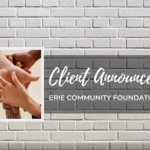The 2019 Bridge Conference was an overwhelming success and a great experience for the Schultz & Williams team. Collectively, we had a 360-degree outlook on the conference: Vice President Matt Brown was one of the Bridge chairs; S&W sponsored the Executive Leadership Track; Director, Digital Experience Brad Levinson presented on list building through social media with our clients Lizzy Ludwig from International Campaign for Tibet and Cecelia Cizek from the Newseum; and S&W staffed a booth in the Solutions Showcase, allowing us to interact with organizations and vendors alike.
The following are a few of our team’s key takeaways from the event.
Identifying Major Donor Prospects: Finding the Needle in the Haystack
Samantha Green, Project Manager
An all-too-common challenge across nonprofit development programs is knowing which specific low- and mid-level donors to target for elevated giving. Considering that staff capacity for conducting qualification calls and visits is almost always a limiting factor, how can organizations know which prospects they should prioritize for more personalized outreach? Often times this process can feel like finding a needle in a haystack. Presenters at the Bridge Conference offered myriad strategies for revealing donors among populous low- and mid-level prospect pools who, with proper cultivation, can be elevated to the major gift level.
Evaluation of donor behavior should always be a factor in assessing potential wealth and inclination to give. Some key behaviors to look for are frequent travel, mention of homes and other significant assets, and unsolicited increases in giving. Moreover, there are numerous data analysis tactics that can be utilized to uncover donors with both high capacity and philanthropic propensity. These strategies include:
- Wealth Screening
Plan to conduct a wealth screening on a regular basis through vendors such as DonorSearch, iWave and Wealth Engine. A common tool in the development professional’s toolbox, wealth screening provides comprehensive data on donor capacity, philanthropic propensity and affinity to the organization. - Zip Code Assessment
Flag donors that live in high-income zip codes and consider segmenting their communications. Several tools are available online (often at no cost) for purposes of evaluating zip code demographics. These tools include Claritas Zip Code Lookup and Esri Tapestry Segmentation. - Predictive Modeling
Consider utilizing a data analyst to conduct predictive modeling of your donor file. This process can identify specific donors who have not yet given at the major gift level but have both the capacity and affinity (demonstrated through recency, frequency and amount of their giving over time) to do so. - Donor Engagement/Capacity Matrix
When working with a large donor pool, be sure to prioritize those who are characterized by both high capacity and engagement with your organization. Matrix tools, such as those available with Tableau, may be helpful for visualizing your prioritization of such prospects.
 Digital Donor Expectations
Digital Donor Expectations
Steven Berman, Associate Account Executive
Several sessions at the conference covered successful digital tactics that are working for either the presenters’ organizations or industry wide. Throughout these sessions, one common thread for success emerged: creating a seamless and modern experience for donors.
In the world of direct mail, the tried and true “old school” approach continues to work. But the same donor who faithfully donates to you through the mail is going to have different expectations in the digital world; consumers in 2019 do not accept out-of-date digital experiences in any way.
As fundraisers, when we are developing a direct mail package, one of the questions we ask ourselves is, Are we making it easy for the recipient to donate? Large text for easy reading, an uncrowded and concise reply device, and a convenient return envelope are essential elements of a direct mail package—we want nothing to stand in the way of an eager donor. But what about those who want to donate while engaging with your organization online? The quickest way for a nonprofit to fall behind in the digital space is to give donors an experience that is behind the times.
Simply put, sending your donors to a form to enter their payment information is not enough to secure a donation. The digital and mobile landscape is expanding (our attention spans and the time it takes us to form first impressions…not so much!) and with that, expectations are rising. This crowded space means that we’ve been conditioned to expect everything to be ready to go and at our fingertips.
Let’s say you have a donor who gives faithfully to all five of your direct mail appeals but has decided for convenience she wants to become a monthly donor. She goes to your website and is met with one of two scenarios.
In scenario A, the hunt begins. Where and how does she donate? She goes through your dropdown menus and finally finds “Ways to Give.” On this page, listed out are eight different funds she can donate to. The donor is a little unsure how any of this relates to the cancer patients she wants to help on a monthly basis, but she selects a fund. Once redirected, she completes the donation form before realizing there is a link to a separate page for monthly giving. The donor clicks that page, and to her frustration, all the information she already entered has been cleared out. Pressed for time, the donor decides she’ll work on this after food shopping.
A donor should never feel that her donation is something she needs to “work” on. Needless to say, in scenario A, a monthly donation that could have been secured might not happen now.
In scenario B, the donor is greeted with a lightbox asking for a donation. There is also a large “Donate” link at the top right corner of the webpage, just in case she closes out of the lightbox. She clicks through and is brought to a page that allows her to toggle between “one-time gift” and “monthly gift.” On this page, the donor enters her personal information, gift amount and payment information. The page will not redirect until all required fields are complete. The result? Your organization just added one monthly donor!
 Data Privacy and Security
Data Privacy and Security
Harmony Tasker-Avalos, Senior Account Coordinator
If you weren’t concerned about the future of data privacy legislation, you should be. Fortunately, presenters and attendees at the Bridge Conference were, and they shared a wealth of information on the topic. One thing is for sure: Organizations, agencies and list brokers will all be affected by new data privacy laws. What’s a little uncertain, however, is how extensive the effects will be. The largest factor right now is whether Congress will act quickly to pass a data privacy law covering the entire United States and superseding any state laws that are being written or are already in place. If Congress is not able to pass comprehensive legislation, we will be left to navigate a wide-ranging patchwork of state-level regulations.
Regardless, such a federal law will not be passed before California’s privacy law becomes active in 2020. Every nonprofit organization who wishes to continue fundraising in California or from California residents must be informed and prepared to deal with the impact of these new legal requirements. What this means for S&W is that it’s necessary to work with all our clients and marketing partners to ensure we are all aware of the law and have thought through the potential impact this will have on fundraising.
For nonprofit organizations this means informing staff and volunteers about new developments and drafting standard language to be used when inquiries and phone calls from donors are received. Nonprofit organizations who use mail and digital donor-acquisition tools should be working with their list brokers and other consulting partners to ensure these for-profit companies are complying with all aspects of the new laws that they are required to adhere to.
On the other side, agencies and list brokers must have appropriate protocols in place for handling data inquiries and removal requests. They also need to ensure their company technology and security procedures are following best practice and meet the minimum requirements of the new laws. This isn’t something that can be done once and forgotten. Constant monitoring and audits of all safeguards must be in place and part of an ongoing process.





